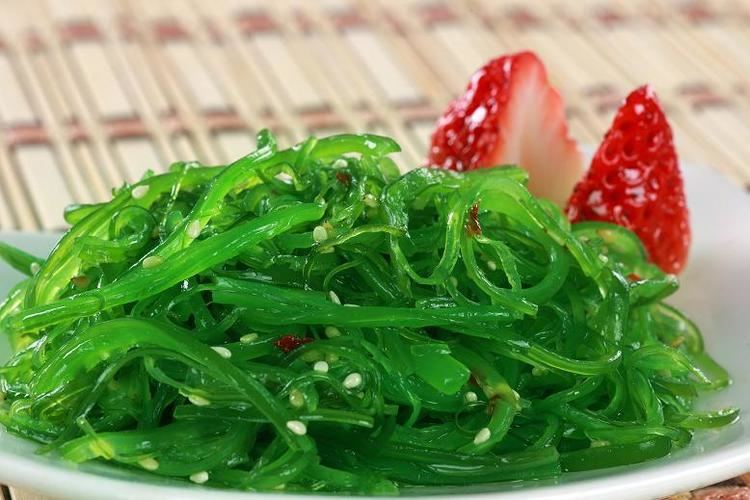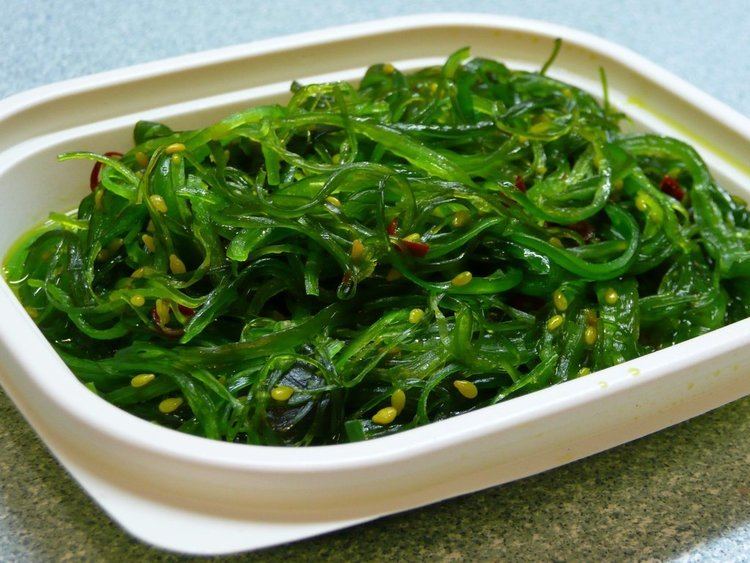Superphylum Heterokonta Order Laminariales | Class Phaeophyceae Family Alariaceae Species U. pinnatifida | |
Similar Seaweed, Nori, Miso soup, Kombu, Miso | ||
How to make seaweed salad wakame salad
Wakame (ワカメ, wakame), Undaria pinnatifida, is a sea vegetable, or edible seaweed. It has a subtly sweet flavour and is most often served in soups and salads.
Contents
- How to make seaweed salad wakame salad
- Wakame seaweed salad may lower blood pressure
- Names
- Etymology
- History in the West
- Health
- Aquaculture
- Cuisine
- Invasive species
- New Zealand
- United States
- References

Sea-farmers have grown wakame in Japan since the Nara period. The Invasive Species Specialist Group has listed Undaria pinnatifida on its list of 100 worst globally invasive species.

Wakame seaweed salad may lower blood pressure
Names
The name "wakame" was derived from the Japanese name wakame (ワカメ, わかめ, 若布, 和布).

Etymology

In Old Japanese, me stood for edible seaweeds in general as opposed to mo standing for algae. In kanji, such as 海藻, 軍布 and 和布 were applied to transcribe the word. Among seaweeds, wakame was likely most often eaten, therefore me especially meant wakame. It expanded later to other seaweeds like kajime, hirome (kombu), arame, etc. Wakame is derived from waka + me (若布, lit. young seaweed). If this waka is an eulogistic prefix, same as the tama of tamagushi, wakame likely stood for seaweeds widely in ancient ages. In Man'yōshū, in addition to 和可米 and 稚海藻 (both are read as wakame), nigime (和海藻, soft wakame) can be seen. Besides, tamamo (玉藻, lit. beautiful algae), which often appeared in Man'yo-shu, may be wakame depending on poems.
History in the West
The earliest appearance in Western documents is probably in Nippo Jisho (1603), as Vacame.

In 1867 the word "wakame" appeared in an English-language publication, A Japanese and English Dictionary, by James C. Hepburn.

Starting in the 1960s, the word "wakame" started to be used widely in the United States, and the product (imported in dried form from Japan) became widely available at natural food stores and Asian-American grocery stores, due to the influence of the macrobiotic movement, and in the 1970s with the growing number of Japanese restaurants and sushi bars.
Health
New studies conducted at Hokkaido University have found that a compound in wakame known as fucoxanthin can help burn fatty tissue. Studies in mice have shown that fucoxanthin induces expression of the fat-burning protein UCP1 that accumulates in fat tissue around the internal organs. Expression of UCP1 protein was significantly increased in mice fed fucoxanthin. Wakame is also used in topical beauty treatments. See also Fucoidan.
Wakame is a rich source of eicosapentaenoic acid, an omega-3 fatty acid. At over 400 mg/(100 kcal) or almost 1 mg/kJ, it has one of the higher nutrient-to-energy ratios for this nutrient, and among the very highest for a vegetarian source. A typical 10–20 g (1–2 tablespoon) serving of wakame contains roughly 16 to 31 kJ (3.75 to 7.5 kcal) and provides 15–30 mg of omega-3 fatty acids. Wakame also has high levels of sodium, calcium, iodine, thiamine and niacin.
In Oriental medicine it has been used for blood purification, intestinal strength, skin, hair, reproductive organs and menstrual regularity.
In Korea, the soup miyeokguk is popularly consumed by women after giving birth as sea mustard (miyeok) contains a high content of calcium and iodine, nutrients that are important for nursing new mothers. Many women consume it during the pregnancy phase as well. It is also traditionally eaten on birthdays for this reason, a reminder of the first food that the mother has eaten and passed on to her newborn through her milk.
Aquaculture
Japanese and Korean sea-farmers have grown wakame for centuries, and are still both the leading producers and consumers. Wakame has also been cultivated in France since 1983, in sea fields established near the shores of Brittany.
Wild grown wakame is harvested in Tasmania, Australia, and then sold in restaurants in Sydney and also sustainably hand-harvested from the waters of Foveaux Strait in Southland, New Zealand and freeze-dried for retail and use in a range of products.
Cuisine
Wakame fronds are green and have a subtly sweet flavour and satiny texture. The leaves should be cut into small pieces as they will expand during cooking.
In Japan and Europe, wakame is distributed either dried or salted, and used in soups (particularly miso soup), and salads (tofu salad), or often simply as a side dish to tofu and a salad vegetable like cucumber. These dishes are typically dressed with soy sauce and vinegar/rice vinegar.
Goma wakame, also known as seaweed salad, is a popular side dish at American and European sushi restaurants. Literally translated, it means "sesame seaweed", as sesame seeds are usually included in the recipe.
Invasive species
Native to cold temperate coastal areas of Japan, Korea, and China, in recent decades it has become established in temperate regions around the world, including New Zealand, the United States, Belgium, France, Great Britain, Spain, Italy, Argentina, Australia and Mexico. It was nominated one of the 100 worst invasive species in the world.
New Zealand
In New Zealand, Undaria pinnatifida was declared as an unwanted organism in 2000 under the Biosecurity Act 1993. It was first discovered in Wellington Harbour in 1987 and probably arrived as hull fouling on shipping or fishing vessels from Asia.
Wakame is now found around much of New Zealand, from Stewart Island to as far north as Karikari Peninsula. It spreads in two ways: naturally, through the millions of microscopic spores released by each fertile organism, and through human mediated spread, most commonly via hull fouling and with marine farming equipment. It is a highly successful and fertile species, which makes it a serious invader. However, its impacts are not well understood and vary depending on the location.
Even though it is an invasive species, in 2012 the government allowed for the farming of wakame in Wellington, Marlborough and Banks Peninsula.
United States
The sea plant has been found in several harbors in southern California. In May 2009 it was discovered in San Francisco Bay and aggressive efforts are underway to remove it before it spreads.
